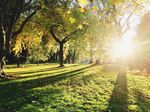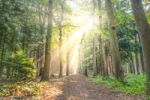Our Director of Head and Heart draws an unlikely — but insightful — comparison.
We'd all benefit from spending more time (or any) in the great outdoors. But even if you don't dedicate weekends to hiking in the mountains or camping under a thick forest canopy, the humble tree — which even city dwellers have access to — can deliver a bounty of inspiration.
Let me explain: On the surface, trees appear to be independent beings, standing separate from one another. However, under the soil, they are linked to one another by a robust and tangled fungal network. Through that network, trees help one another out by sharing nutrients and information.
While it may not seem like it at first glance, humans actually have a good deal in common with trees. We stand upright, have a crown on top and mobile limbs stemming from a central trunk. What's more: The pattern of the tubular branches (bronchi) in our lungs is similar to the root system of many trees.
Being untethered is not a sign of strength; it's a marker of detachment.
Like us, trees stand tall, but not alone. Like us, they are very much a part of a symbiotic community.
But this community is often disrupted. Our cultural narrative and emphasis on "independence" tries to combat this notion that humans, like trees, grow in conjunction with others. The idea that we can do anything without support is a falsehood.
The solution: We need to remember that healing happens in connection. Bring to mind a nourishing relationship with a significant other or a close friend, and be reminded of how much you learned about yourself, how much further your limbs stretched, because of his or her help.
Being untethered is not a sign of strength; it's a marker of detachment. Unite with the people and spaces around you. Show up with a willingness to see the ways that you are the same as, not different from, other people. Develop the capacity to interpret that just like in the case of the seemingly singular tree, there may be an entirely different narrative under the surface.




